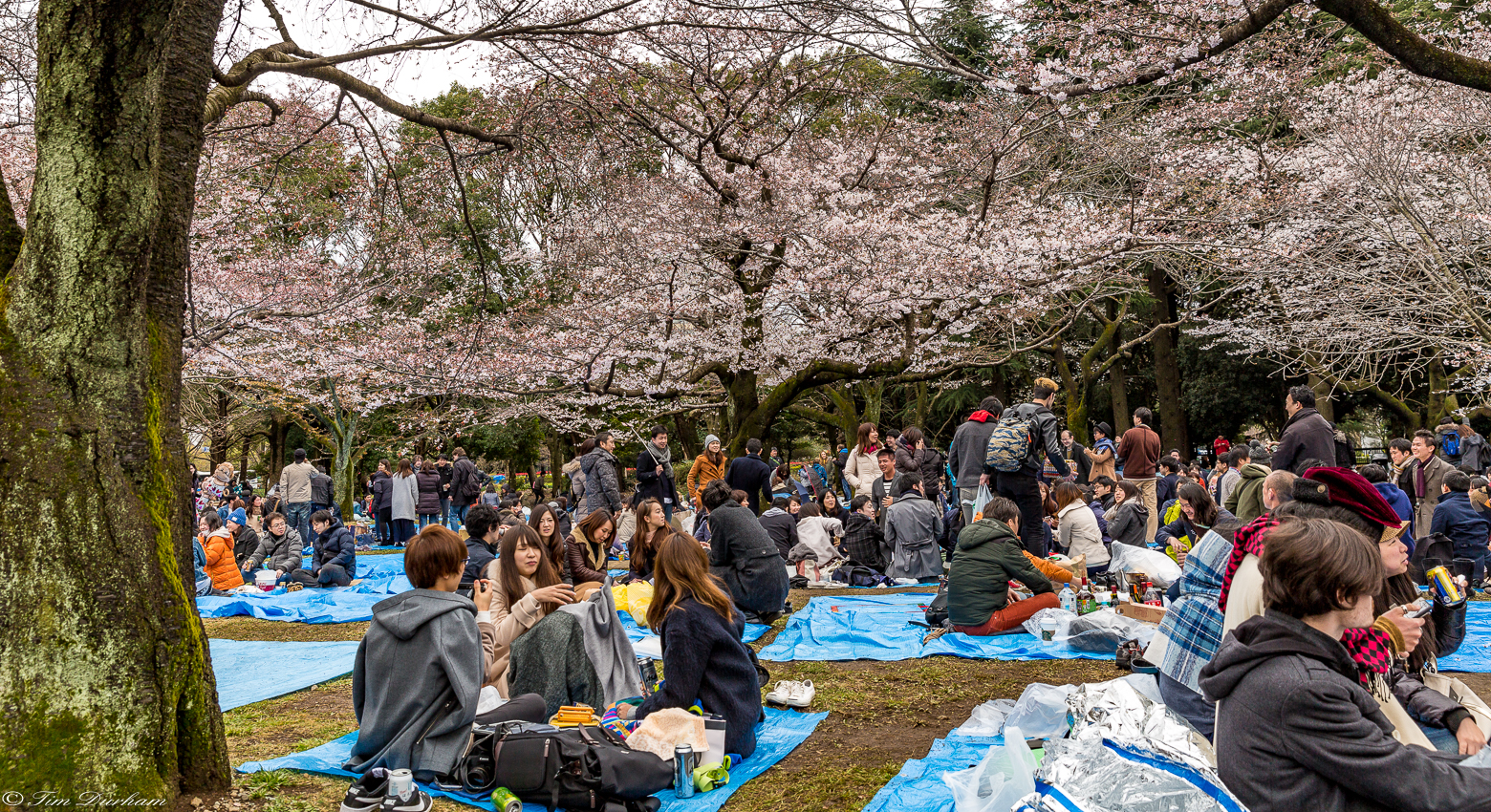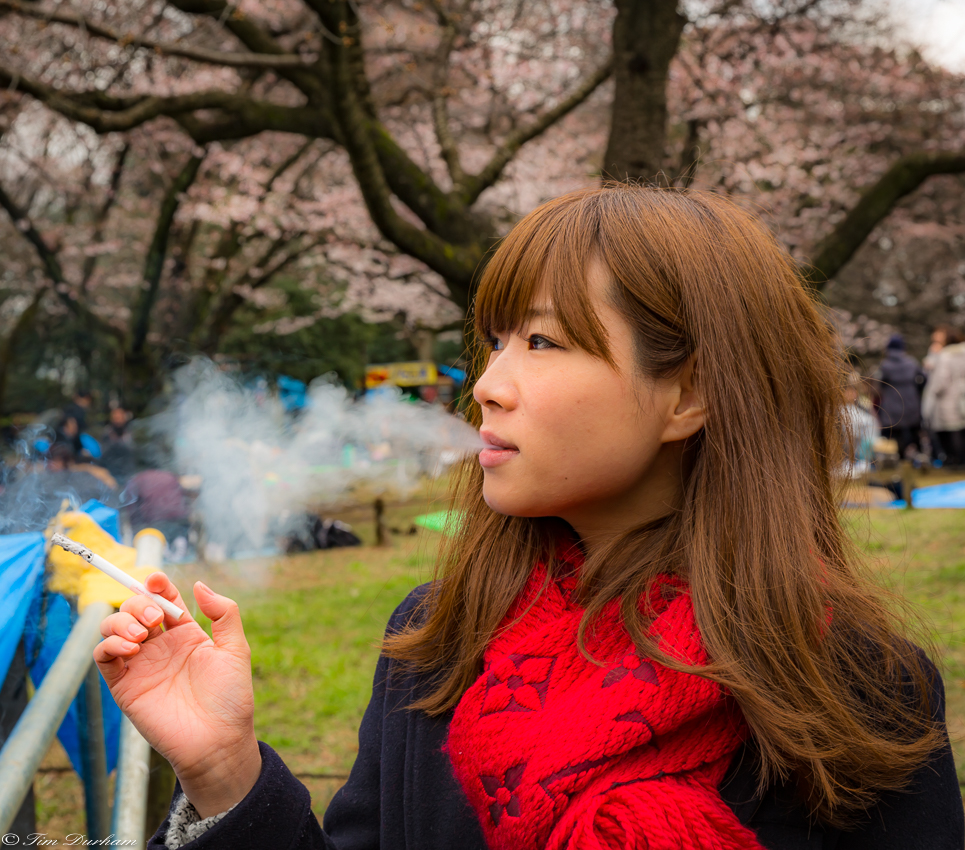So…
We arrived Tokyo late last night. Got a pretty good night’s sleep and today is our wisely planned “day off” to re-adjust our circadian rhythms after the flight over from PDX. Long hours breathing the incredibly dry cabin air in an airplane can seriously dehydrate you and sap your strength.
Shall we just lay around the hotel to re-hydrate, and take naps? The smart answer – Yep, hand me that water bottle. Our answer?
NOPE.
The concierge at the hotel gave us a map (in English!) that showed a nice park just a subway ride away from our hotel. Yoyogi Park is a large park in the Shibuya section of Tokyo, (right in our li’l old Shibuya neighborhood) located adjacent to Harajuku Station and Meiji Shrine. Cool. Our hotel is right next to one of the subway stations. All we have to do is find the train to Harajuku station. Except, there are no signs in English.
Japanese Custom Alert:
Very few people in Japan speak English. Most of the tourists that we came across were other Japanese, with a smattering of Chinese, followed by “other” Asians.
As Winnie and I are standing near one of the ticket machines looking completely lost and totally perplexed, a small voice with a bit of a British clip asks “Can I help you?” Our English-speaking angel of mercy! Turns out this is her third year of studying abroad in Japan and just happens to be on the way to the same park to meet her friends. After briefing us on how to buy a metro ticket and how to calculate from the tables and charts how much to pay, we are on the way.
I just love it when an ill-conceived plan falls together for, seemingly, no reason at all.
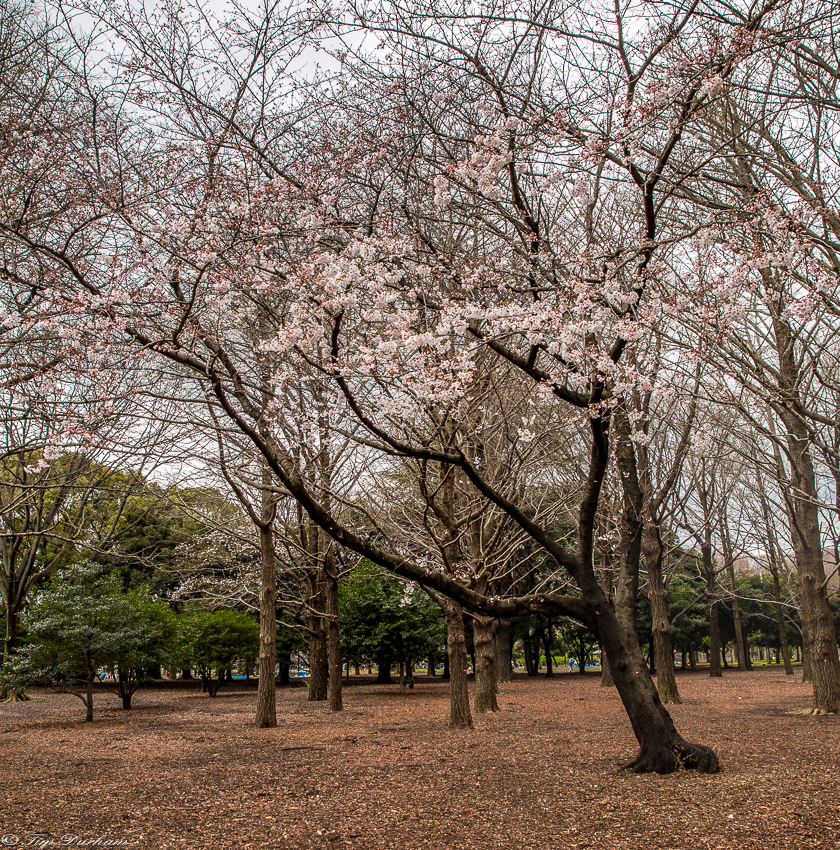
Arriving at Yoyogi Park, we find that the weather has been a bit on the chilly side, and the cherry blossoms are still (maybe) a week away from full bloom. Heck, I think that they’re pretty anyway.
We can see swatches of blue and lots of people just ahead…. We wander over to find out what’s going on.
It’s a PARTY!
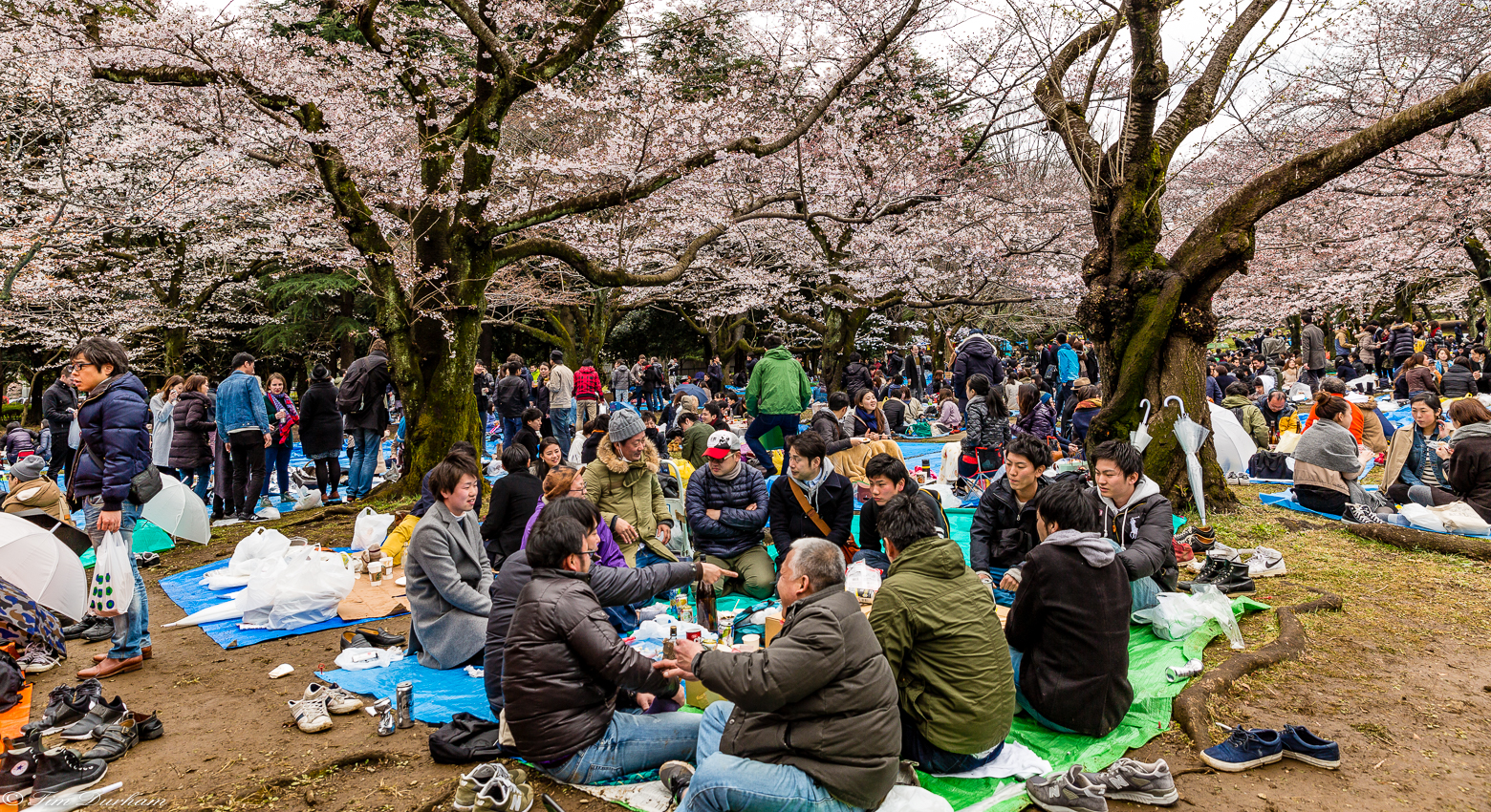
It’s the first day of SAKURA, the Japanese Cherry Blossom Festival and, from the looks of it, everyone has brought a tarp, lots of friends and family, loads of food, and gallons of beer and sake.
And as is Japanese custom, leave your shoes “at the door”.
I was just starting to acquire a twinge of consciousness telling me that the observance of social customs is quite important to the Japanese.
(I had no idea how much I would learn/discover about the importance of social customs when millions of people are mashed together into dense populations.)
Japanese Custom Alert:
It is customary (read that as “mandatory”) that you take off your shoes when entering someone’s home, a ryokan, pretty much any carpeted area, any elevated platform (think shrines or temples), and even certain areas of restaurants.
Travel Tip: Be alert and aware of our surroundings and imitate what the “locals” do.
On the other hand, or foot as it were, you are expected to put on the slippers that are placed next to the door before entering the bathroom.
Going to the bathroom is a big deal in Japan.
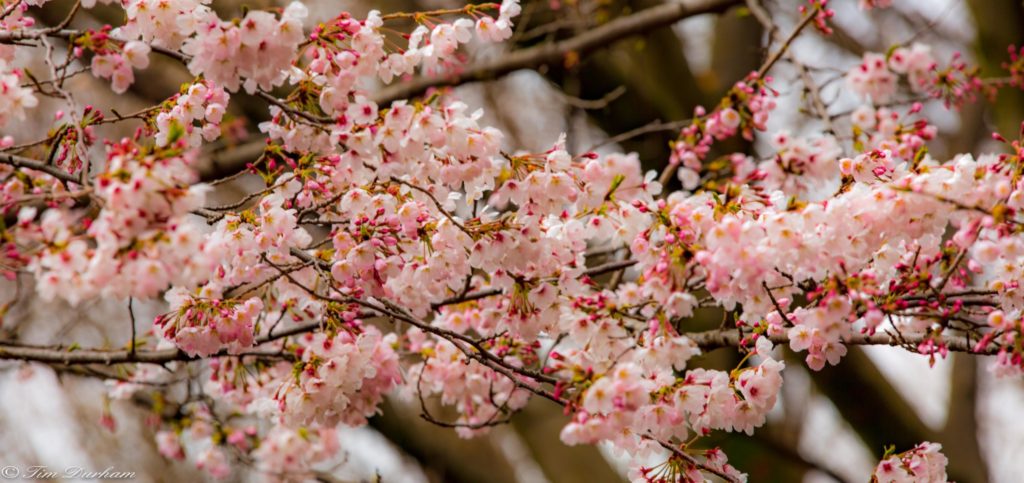
The cherry blossoms must have been enjoying the revelry too, because they were more completely filled out on this side of the park.
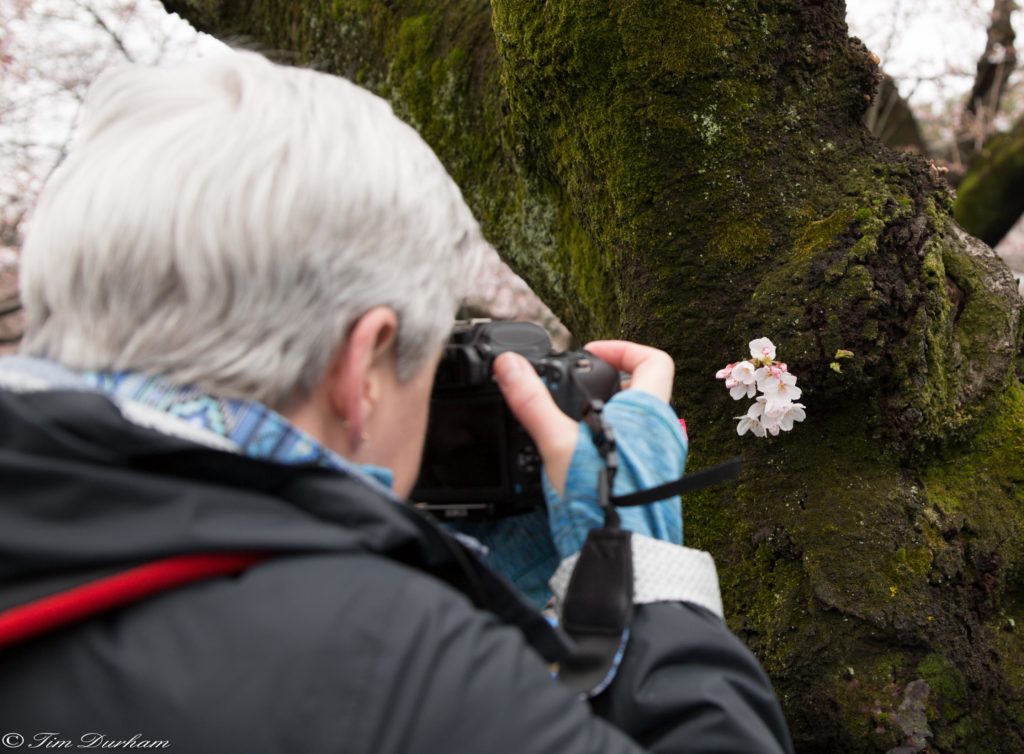
Winnie even found a tiny bloom growing right out of the bark of this big mossy tree.
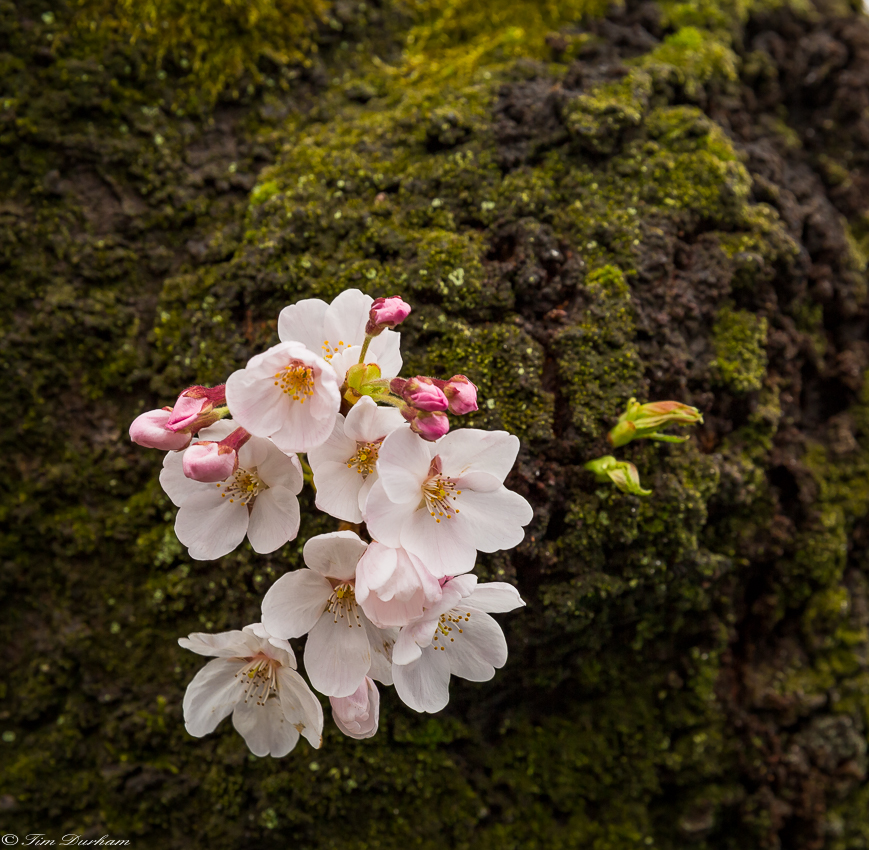
Monkey see, monkey do… So I took a picture of it right after Winnie did.
I got to wondering “Do many photographers watch other photographers (maybe out of the corners of their eyes) for tips or hints?”
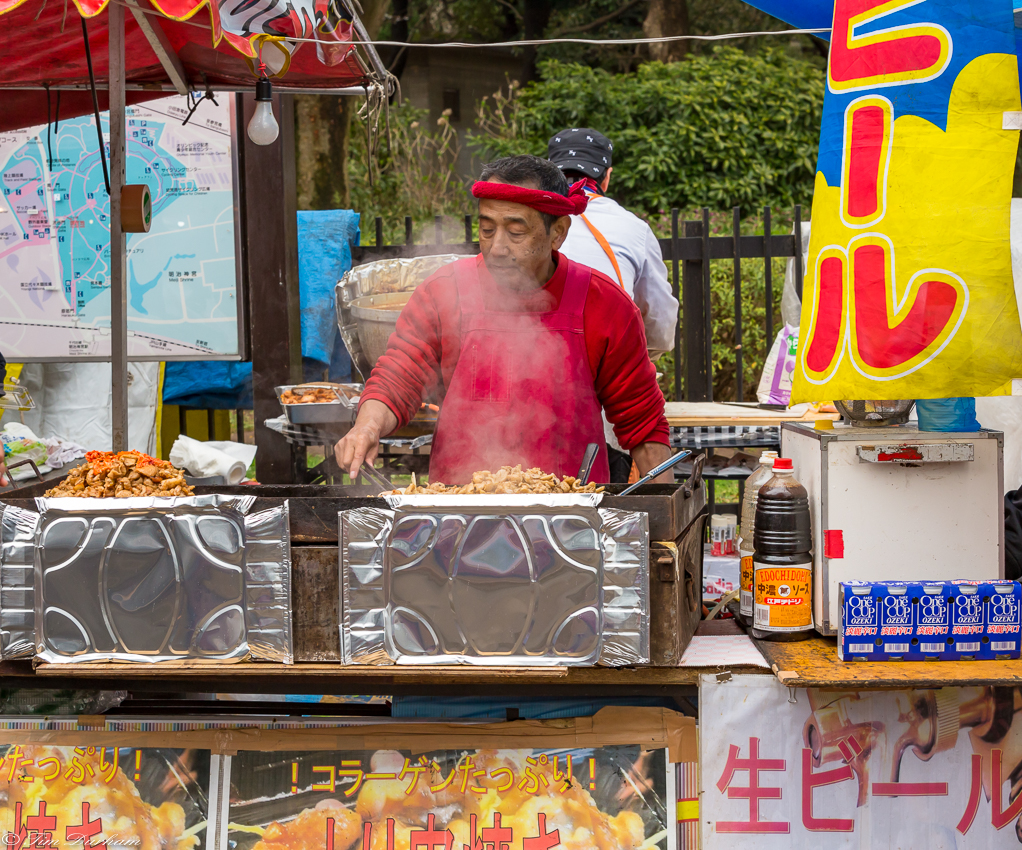
There was a light breeze in the park, and it was carrying some tantalizing aromas. Food aromas.
Time to eat.
There were a dozen kiosks set up by various food vendors, all selling things that I did not recognise. Some of it I did recognise but that’s okay, I just walked a little faster…
If it could be dragged wriggling from the sea, it was there, usually with a skewer stuck through it. Some cooked, some raw, and some for U-Cook-It on a nearby hibachi with an eternal flame. During business hours.
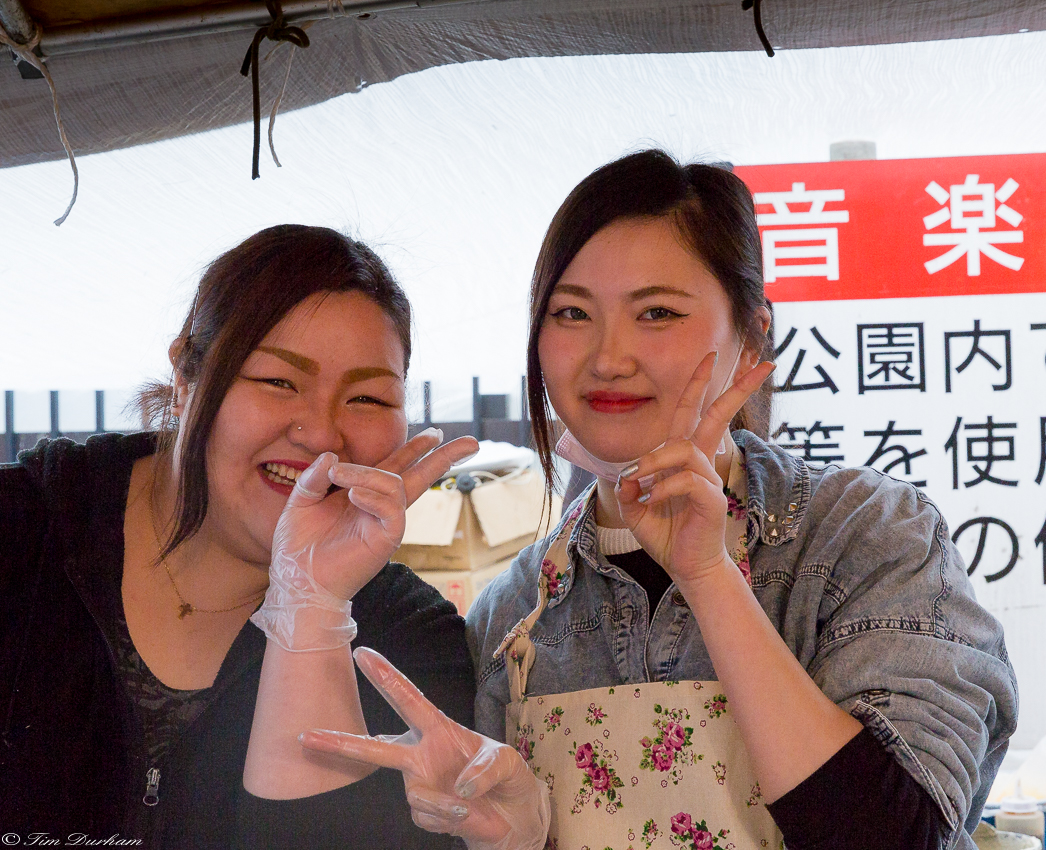
We bought some skewered (and cooked) food like substances from these girls, and added a beer and a coke to wash it all down.
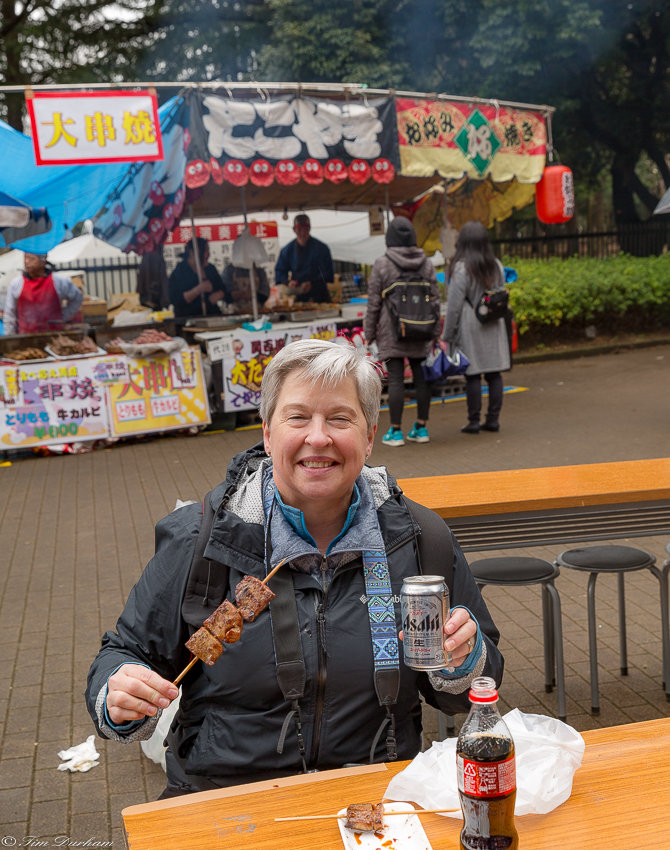
Dining in Style
Never really decided what it was.. beef? pork belly? or the dreaded “Other”?
Whatever it was, it was goooooood!
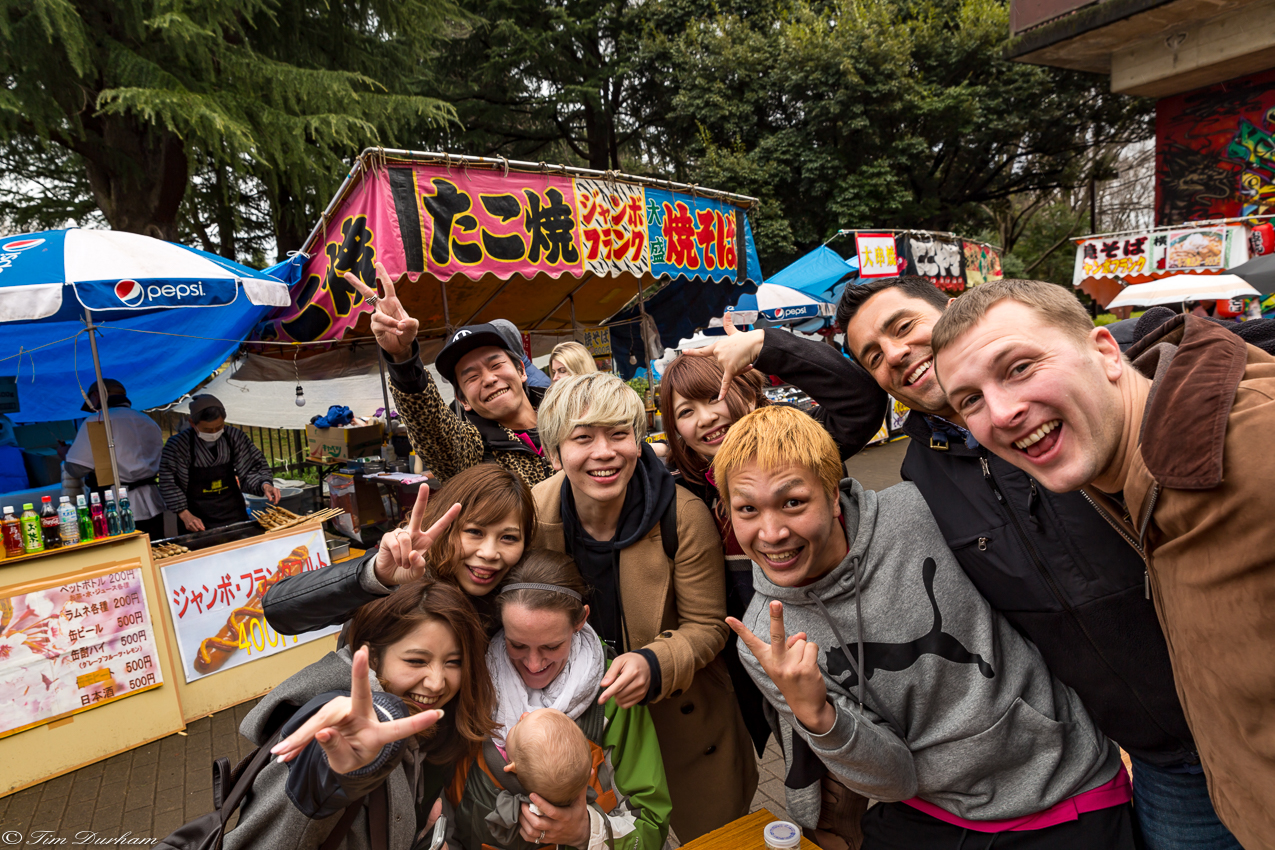
This rowdy bunch of Japanese kids had just met this anglo couple and their baby moments before. They were all really having a good time carrying on and fussing over the baby. Although none of us were bi-lingual, language proved to be no barrier at all. Smiles and laughter were ample connection, though all the beer and saki may have been a contributing factor. What fun!
So.
I joined the party. I laughed and carried on. I took a few “action shots” of the group.
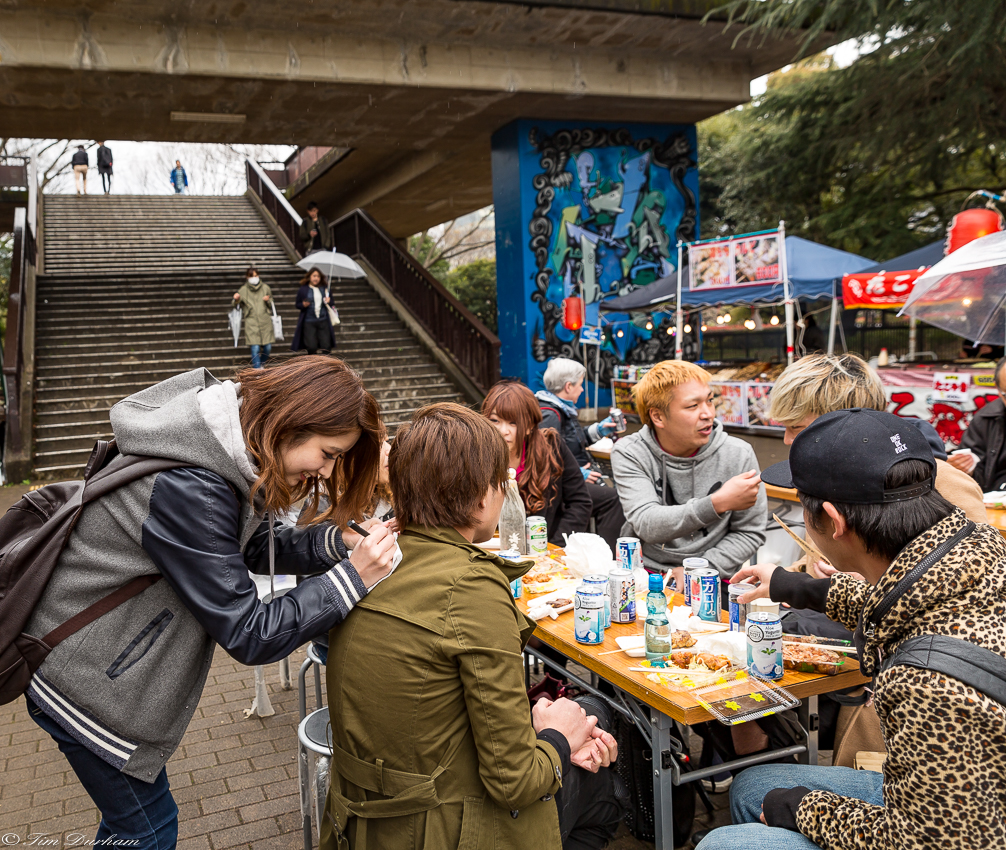
One of the group is writing down her eMail address for me… I developed their group shots and sent them to her the next day so that she could pass them along to her posse.
I really enjoy interacting with people from other countries, even when communication is reduced to a mere smile or laugh.
I thought this young girl was cute, so I mimed the question “Okay to take your picture?” She laughed and struck this pose… and for a Walter Mitty moment in time, she was “The Star”, and I was her “Photographer”. Everyone in the park has been so friendly today. Not a frown to be foun(d).
There are still many smokers in Japan, mostly adult males. And this girl.
Even so, you won’t find any cigarette butts on the ground. Zero. None.
Japanese Custom Alert:
The Japanese take “tidy” to whole new levels, even though one rarely sees a trash can. If you create any “trash” while you’re out and about, put it into your pocket or purse and take it home with you.
I can understand how this could become more and more important as population becomes more and more condensed. I truly hope that this custom might begin to “trend” in the U.S. and other countries.
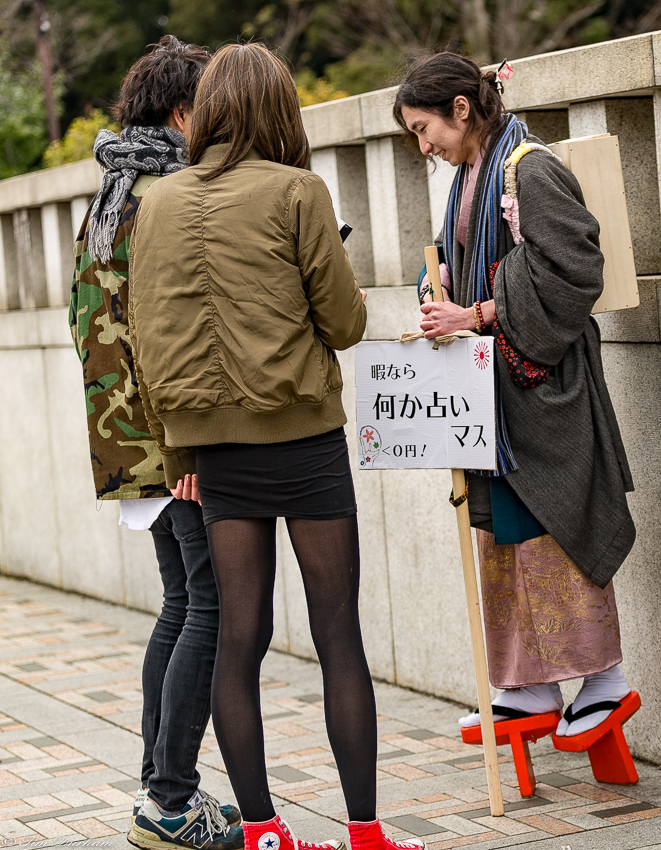
Nice boots, ladies!
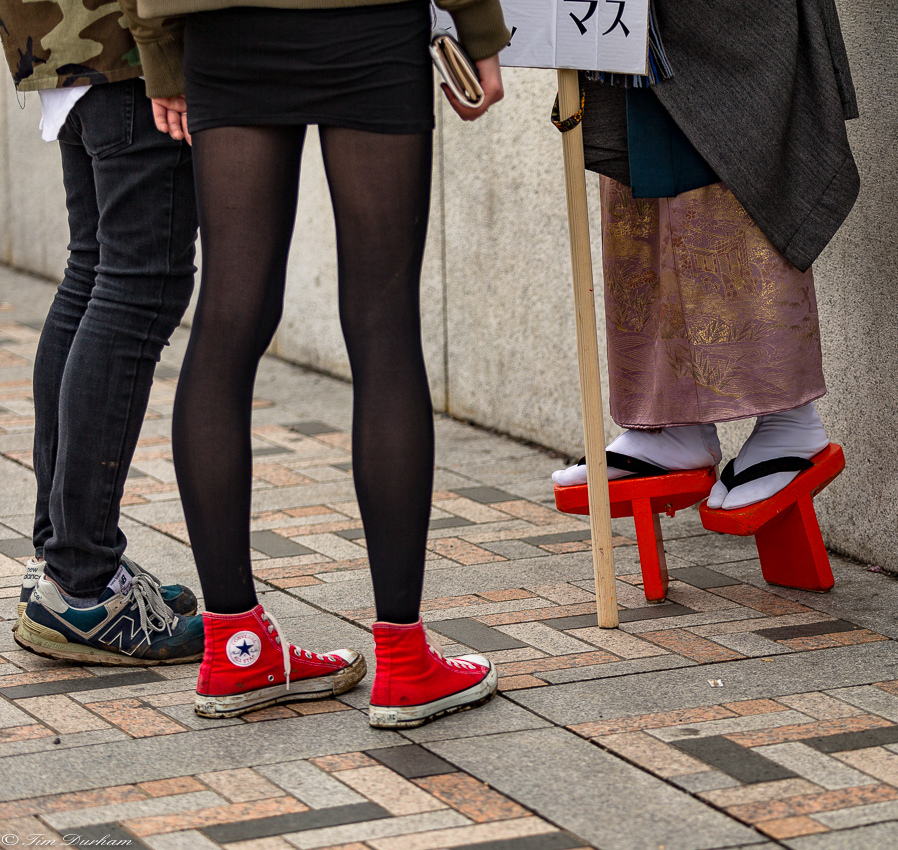
My brother the police officer always told me that he could tell a lot about a person by just looking at their shoes.
What are your thoughts? Can you?
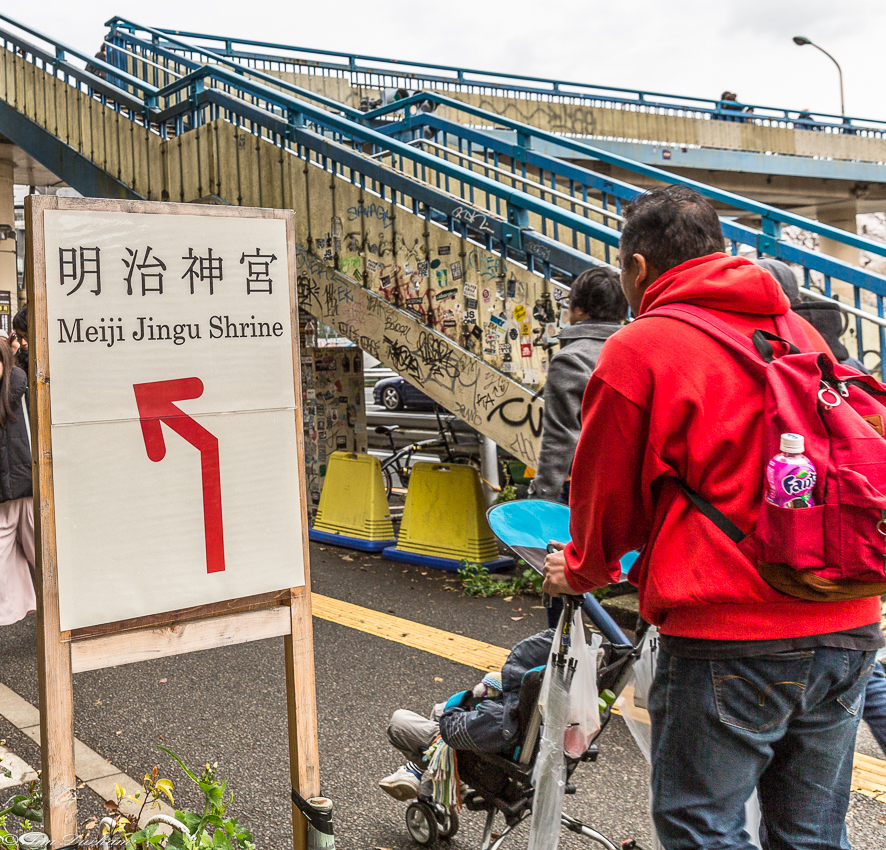
It was a fun morning of partying, but now it’s time to flee the raucous denizens of Yoyogi Park for the peace and tranquility of Meiji Jingu Shrine.
Meiji Jingu Shrine entrance
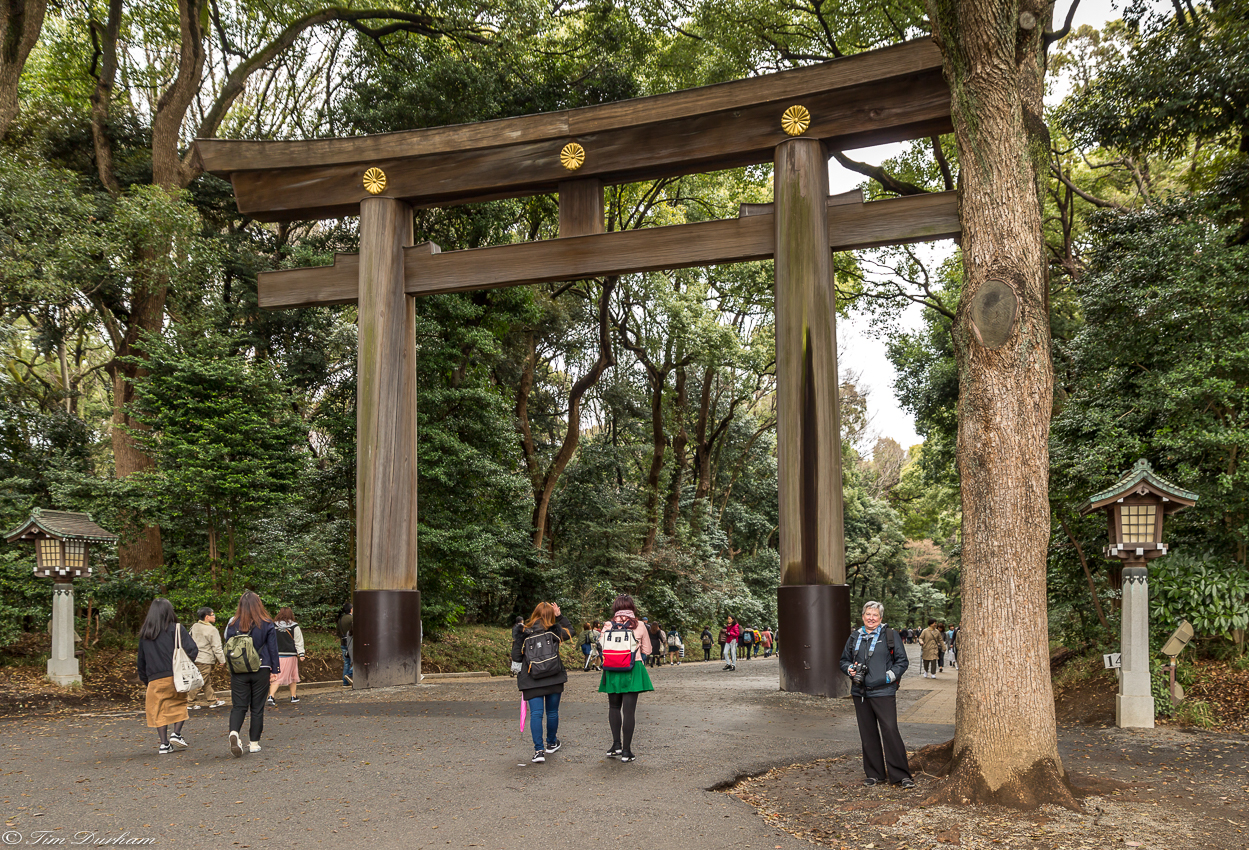
Always bow one time to show respect and honor before entering the 40-foot-high (12-meter) torii gate at the entrance. It is made of 1,500-year-old cypress.
After I bowed once and passed through the torii gate, all the noise from the city, the bands at the park, the kids… seemed to fade. The air about us became peaceful, almost serene. I felt calm. Relaxed. I could now hear birds singing instead of the
city’s roar in my ears. Our rapid pace from the park gently morphed into a stroll so naturally that neither of us even noticed until sometime later. It was truly an oasis of tranquility amidst the stormy sea that is Tokyo.
Meiji Jingu is a Shinto shrine. Shinto is called Japan’s ancient original religion, and it is deeply rooted in the way of Japanese life. Shinto has no founder, no holy book, and not even the concept of religious conversion, but Shinto values (for example) harmony with nature and virtues such as “Magokoro (sincere heart)”.
This shrine is dedicated to the divine souls of Emperor Meiji, the late 19th-century emperor who opened Japan to the West, and his consort Empress Shoken (their tombs are in Kyoto).
Emperor Meiji passed away in 1912 and Empress Shoken in 1914. After their demise, people wanted to commemorate their virtues and to venerate them forever. The Japanese people donated 100,000 trees from all over Japan and from overseas, and countrymen from all over Japan worked voluntarily to create this forest and shrine. Thanks to the Magokoro of the people, this shrine was established on November 1, 1920.
And here we have one of the littlest empresses, all dressed up for Sakura. Her proud Mom was doing the family photo shoot. I simply could not resist a couple of shots of my own.
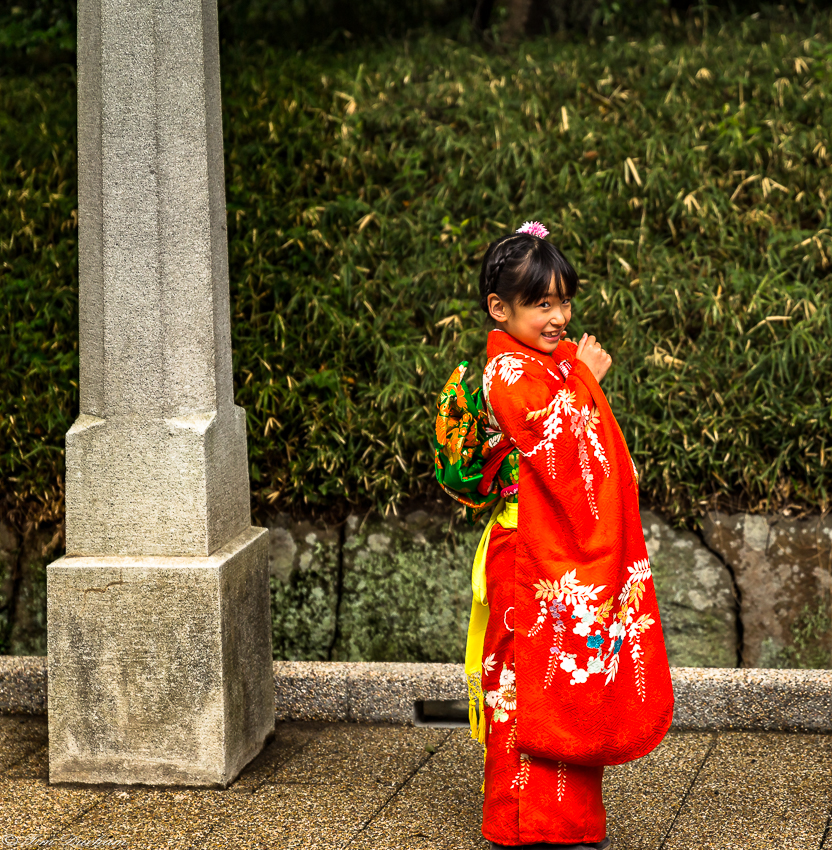
What a totally cute kid.
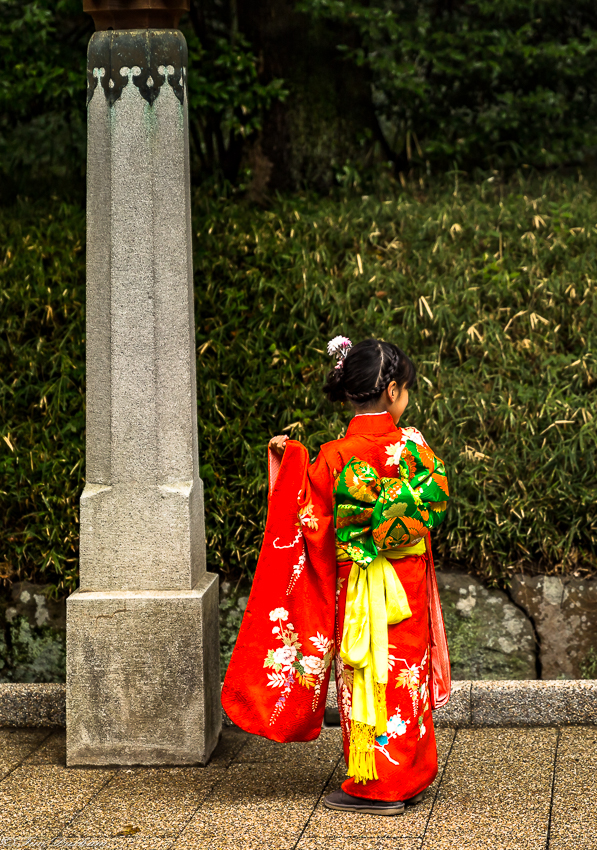
The knot of the obi is called musubi. These days, a woman’s knot often does not keep the obi in place as much as it functions as a large decorative piece in the back. The actual knot is usually supported by a number of accessories including pads, scarves and cords. It’s my understanding that it is quite difficult to don the kimono and attach the obi properly without assistance. The sheer number of customs and traditions involving just the obi might be enough to make a foreign-born woman swoon.
for example…
There are hundreds of decorative knots and they often represent flowers or birds. As everything else in a kimono outfit, the knots are regulated by a number of unwritten propriety rules. Generally the more complex and showy knots are for young unmarried women in festive situations, the more subdued for married or mature women or for use in ceremonial situations.
In earlier days, the knots were believed to banish malicious spirits.
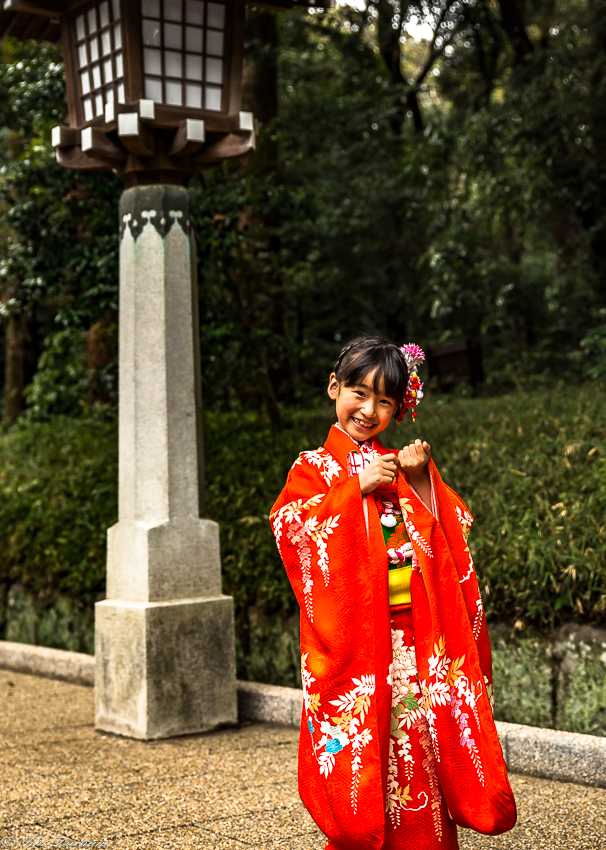
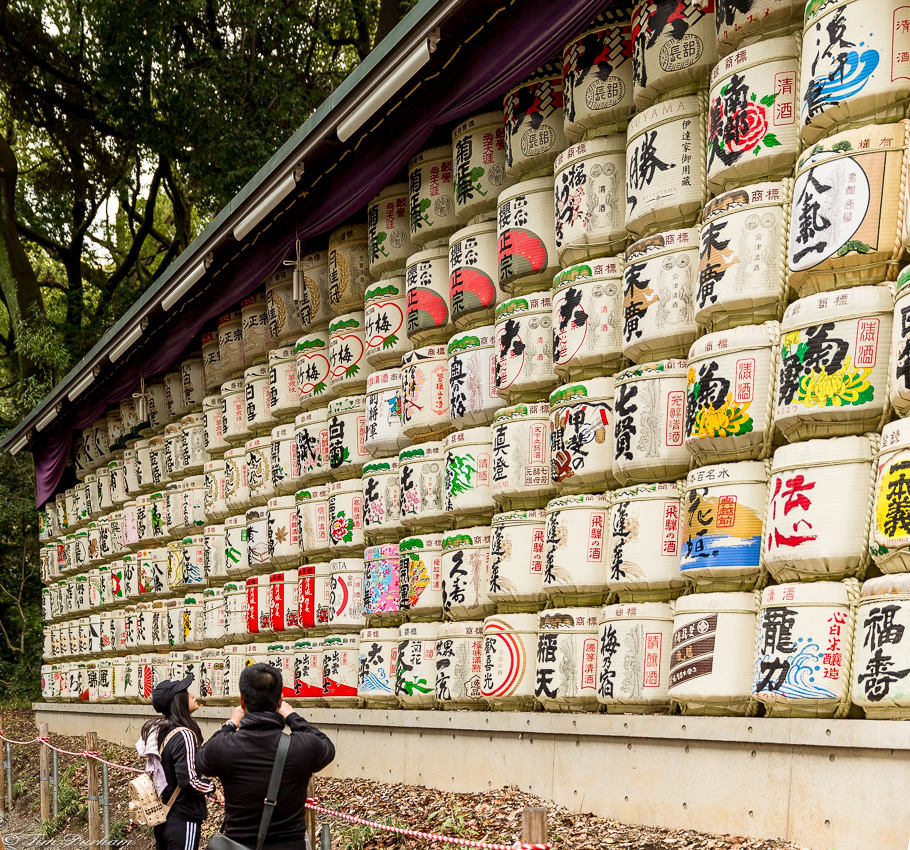
Meiji Jingu Shrine Sake Barrels
As we made our way through the park toward the main shrine, we came upon these beautifully decorative straw covered and hand painted sake barrels. They are called kazaridaru in Japanese.
Sake is the bond between the gods and the people in Japan.
Sake brewers all over Japan donate an empty decorative barrel, or a bottle of their finest sake each year in order to honor the deities enshrined here. The sake itself, is used for ceremonies and festivals. In return, the priests pray for prosperity for the brewers. Everybody wins.

Across the street from the sake barrels, we found these wine barrels on display. Turns out that Emperor Meiji not only liked western clothing, he also acquired the love of a glass of vin rouge with his supper. Maybe two glasses. This eventually led to a tradition of cultural exchange between Japan and France.
About 180 bottles of wine are gifted from about 60 wineries every December from Burgundy, with luxury brands such as Romanee-Conti included on some occasions.
Thus, one side of the street represents Emperor Meiji’s desire to promote internationalization (Vin Rouge from France) while continuing to uphold Japanese tradition (Sake). Harmony.
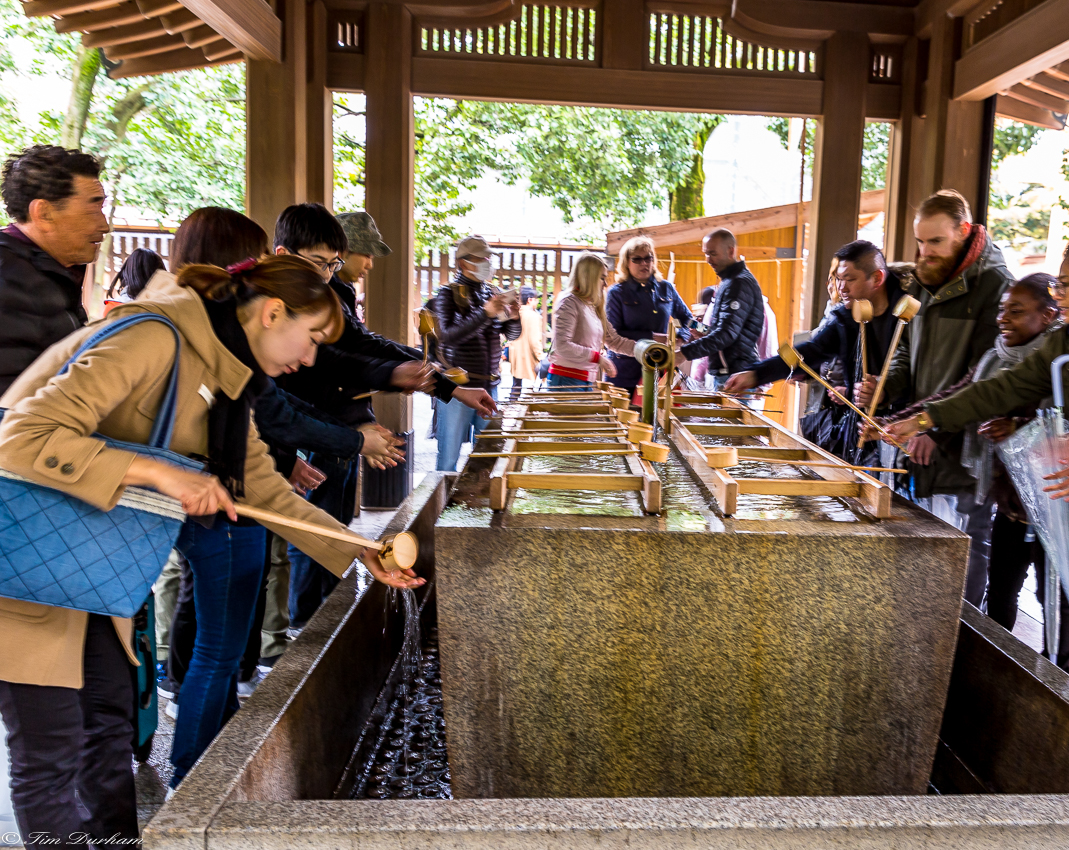
Japanese Custom Alert:
Excerpt from Japan-Guide.com on etiquette:
How to visit a shrine
Behave calmly and respectfully. Traditionally, you are not supposed to visit a shrine if you are sick, have an open wound or are mourning because these are considered causes of impurity.
At the purification fountain near the shrine’s entrance, take one of the ladles provided, fill it with fresh water and rinse both hands. Then transfer some water into your cupped hand, rinse your mouth and spit the water beside the fountain. Custom and tradition dictate that you never let the ladle touch your hand or your mouth. I noticed that quite a few visitors skip the mouth rinsing part or the purification ritual altogether. Just thinking of the hoards of the faithful who have recently washed their hands there kind is kind of off-putting to me, too.
At the offering hall, throw a coin into the offering box, bow deeply twice, clap your hands twice, bow deeply once more and pray for a few seconds. If there is some type of gong, use it before praying in order to get the kami‘s attention.
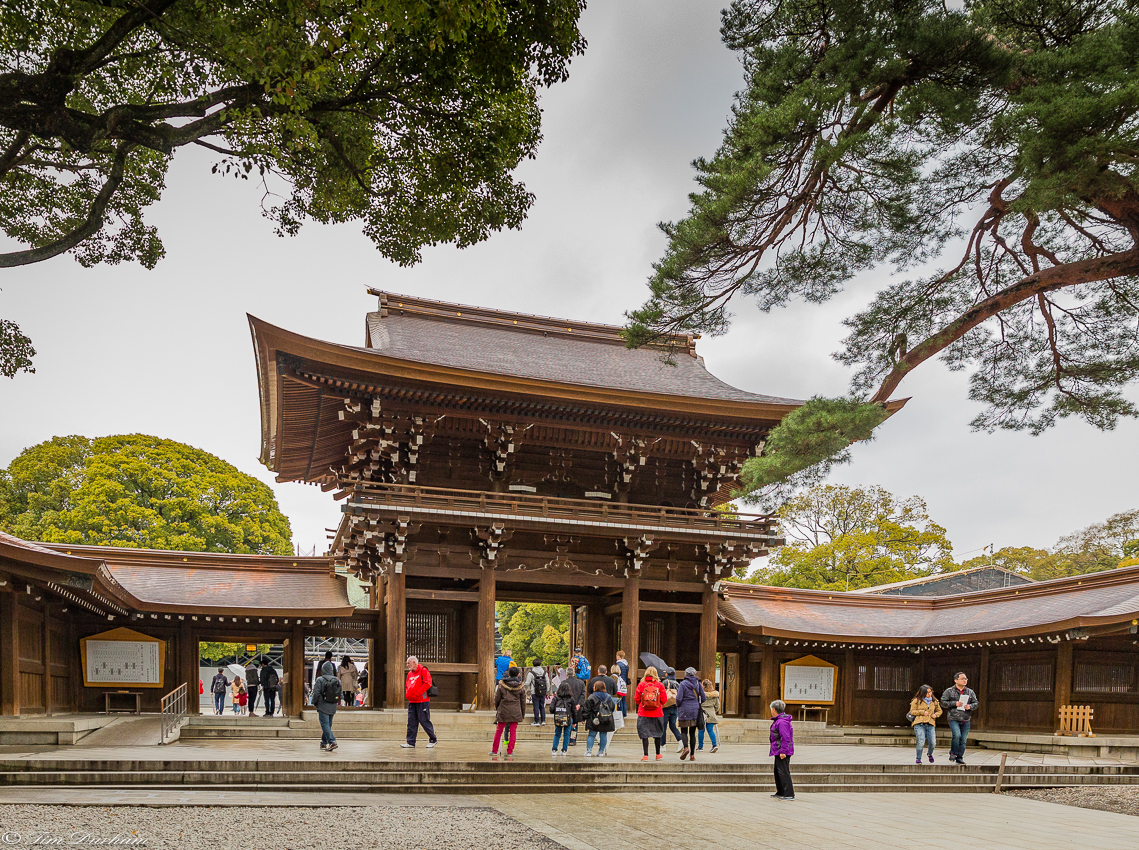
Entrance to the courtyard.
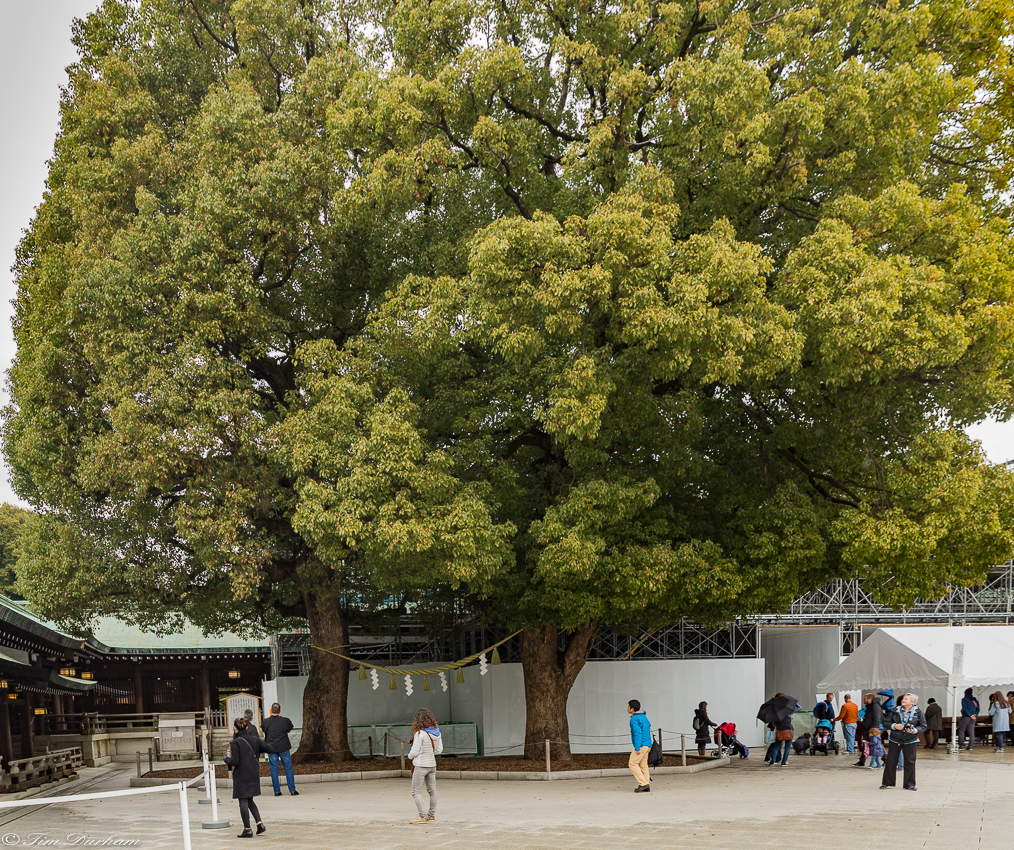
These camphor trees, planted in 1920, are known as “Husband and Wife”
(see below)
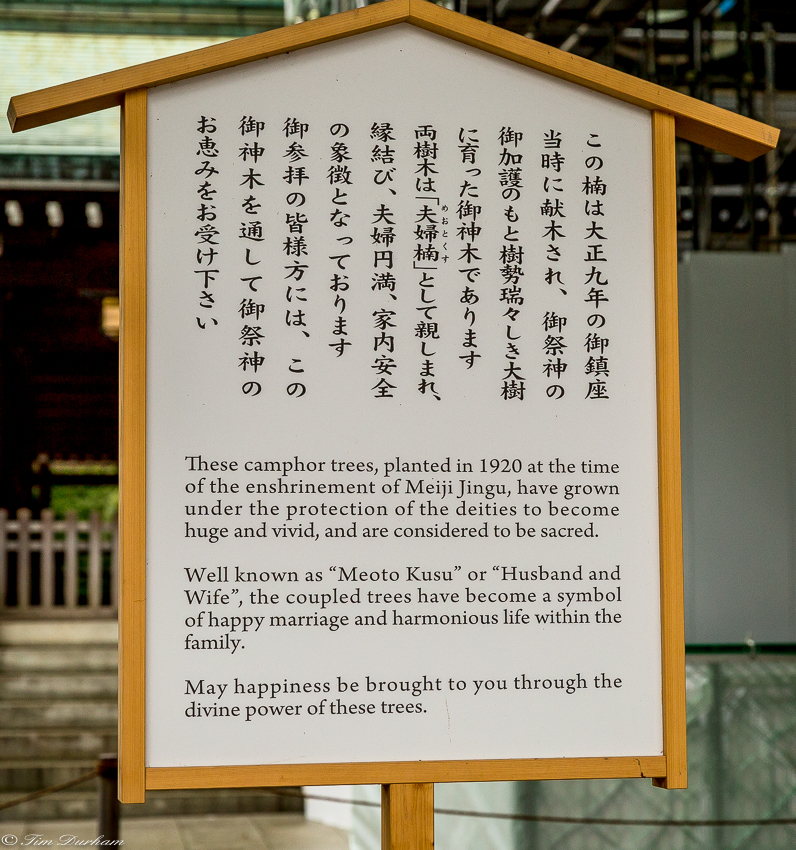
During pre-trip research I dreamed of taking some pics of some traditional ceremony or rites. Dream came true this morning:
A Shinto Wedding procession
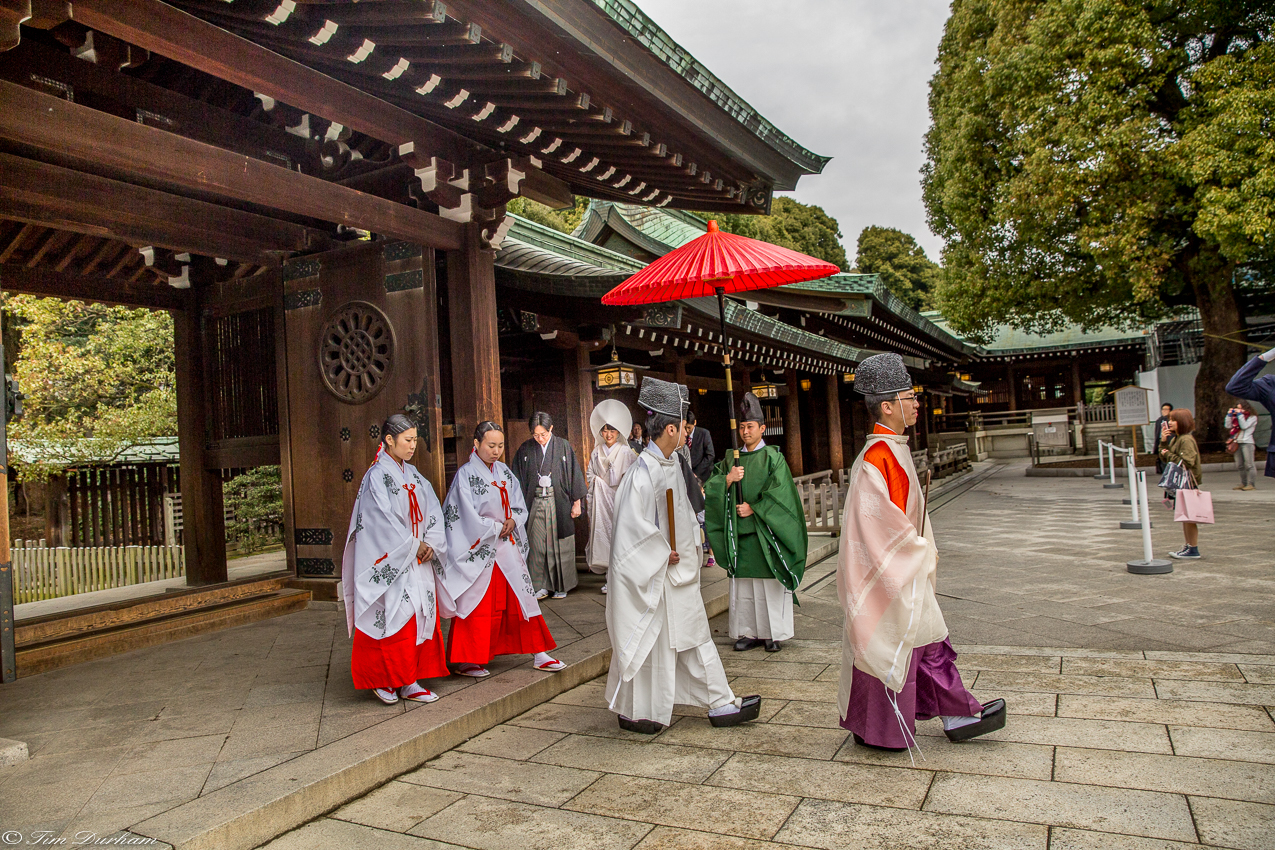
The bride in her traditional white kimono and hood and the groom in his formal black robe, walking together under a big red parasol, with Shinto priests leading the way and the rest of the wedding party trailing behind.
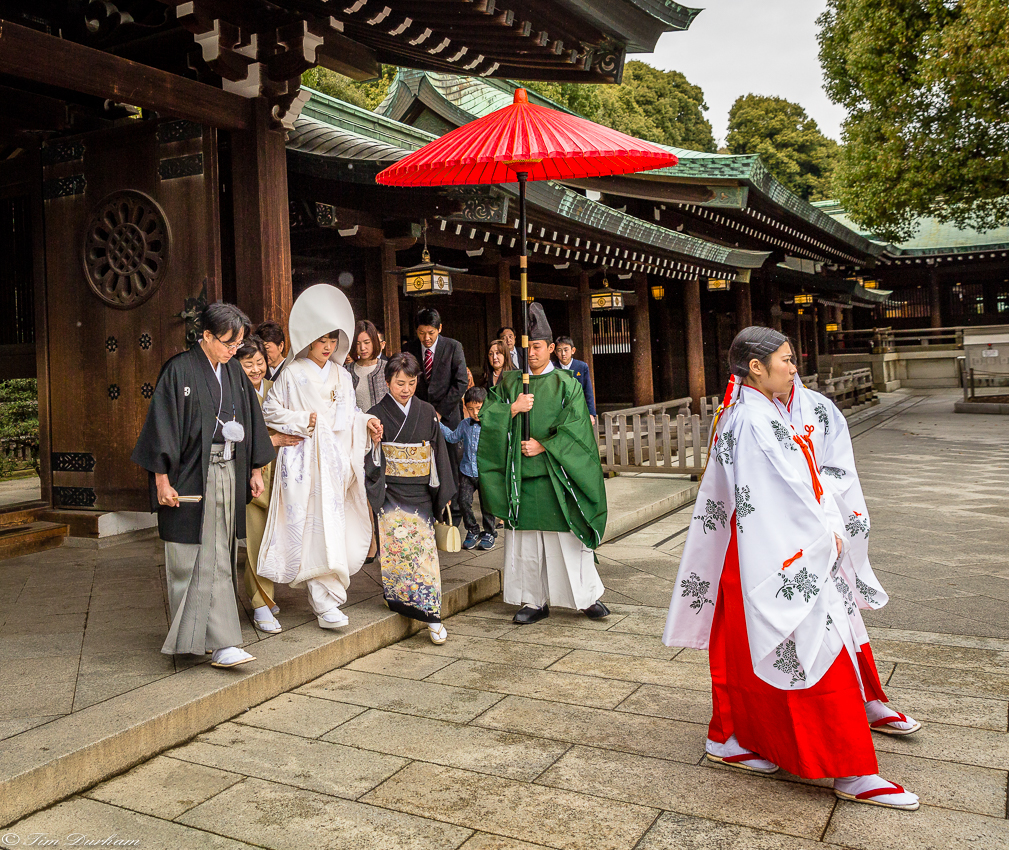
I’m shooting fast with whatever setting happened to be on my camera. Gee, I hope one of these is a nice image… Please?
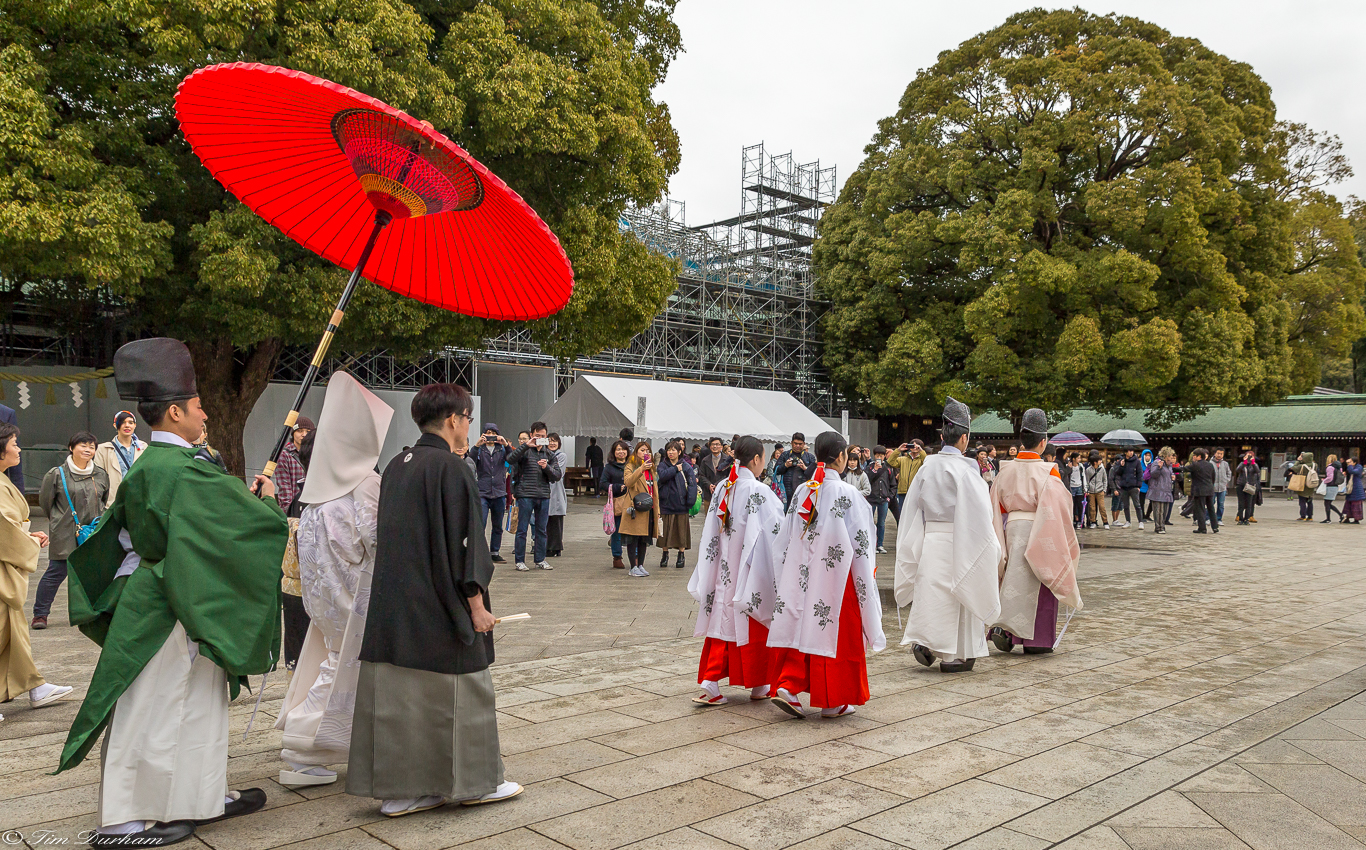
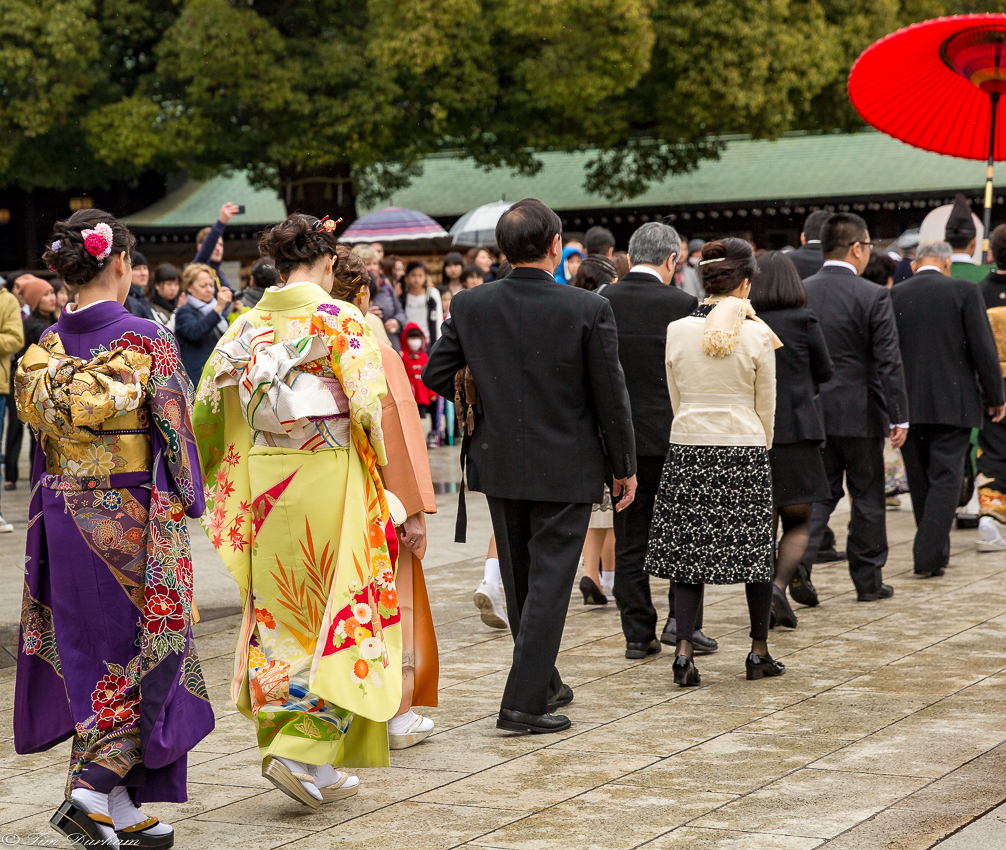
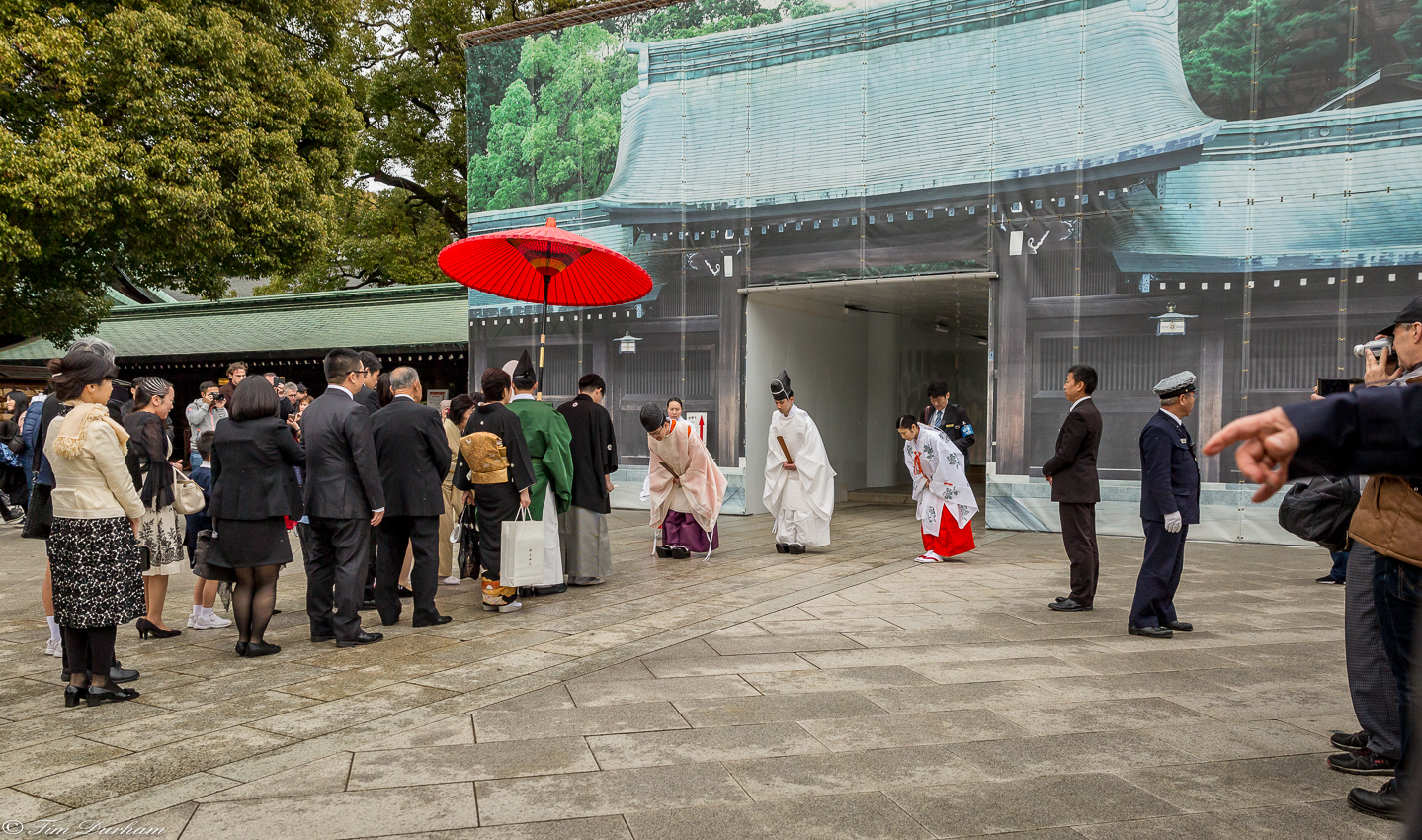
Receiving line: Good luck, you two!
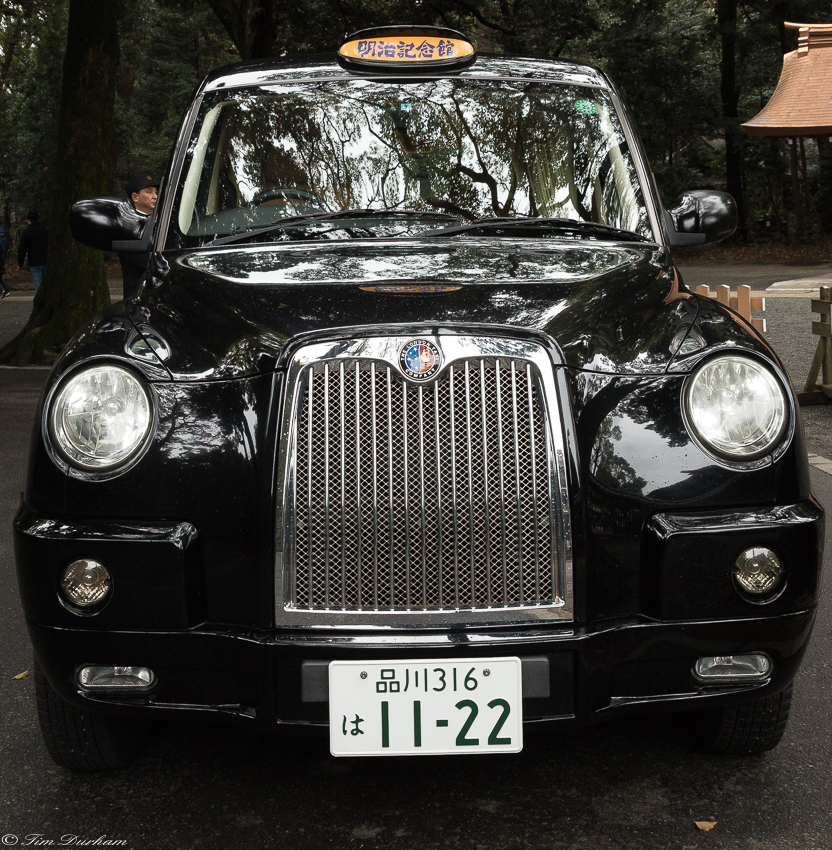
Bride and groom: Your ride’s here…
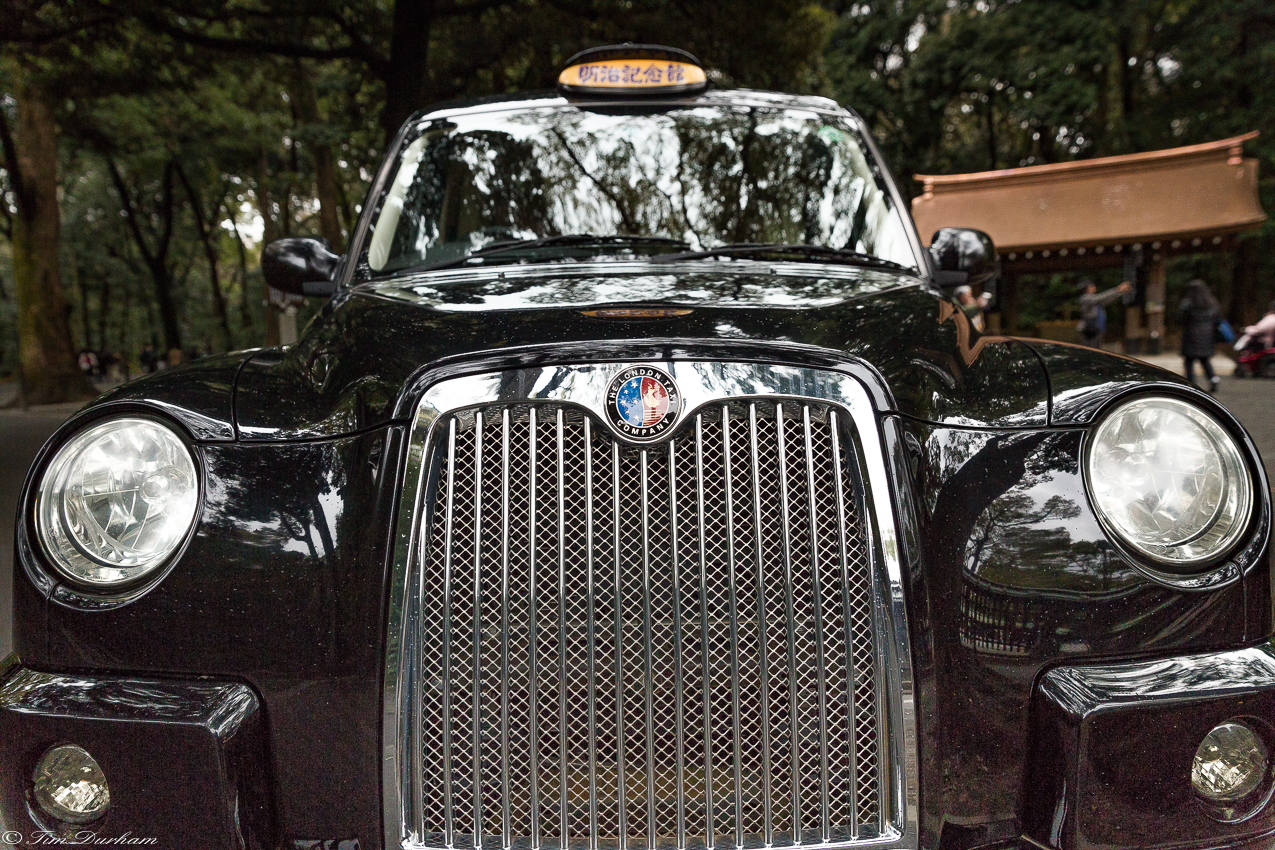
This sled imported especially for you from the London Taxi Company
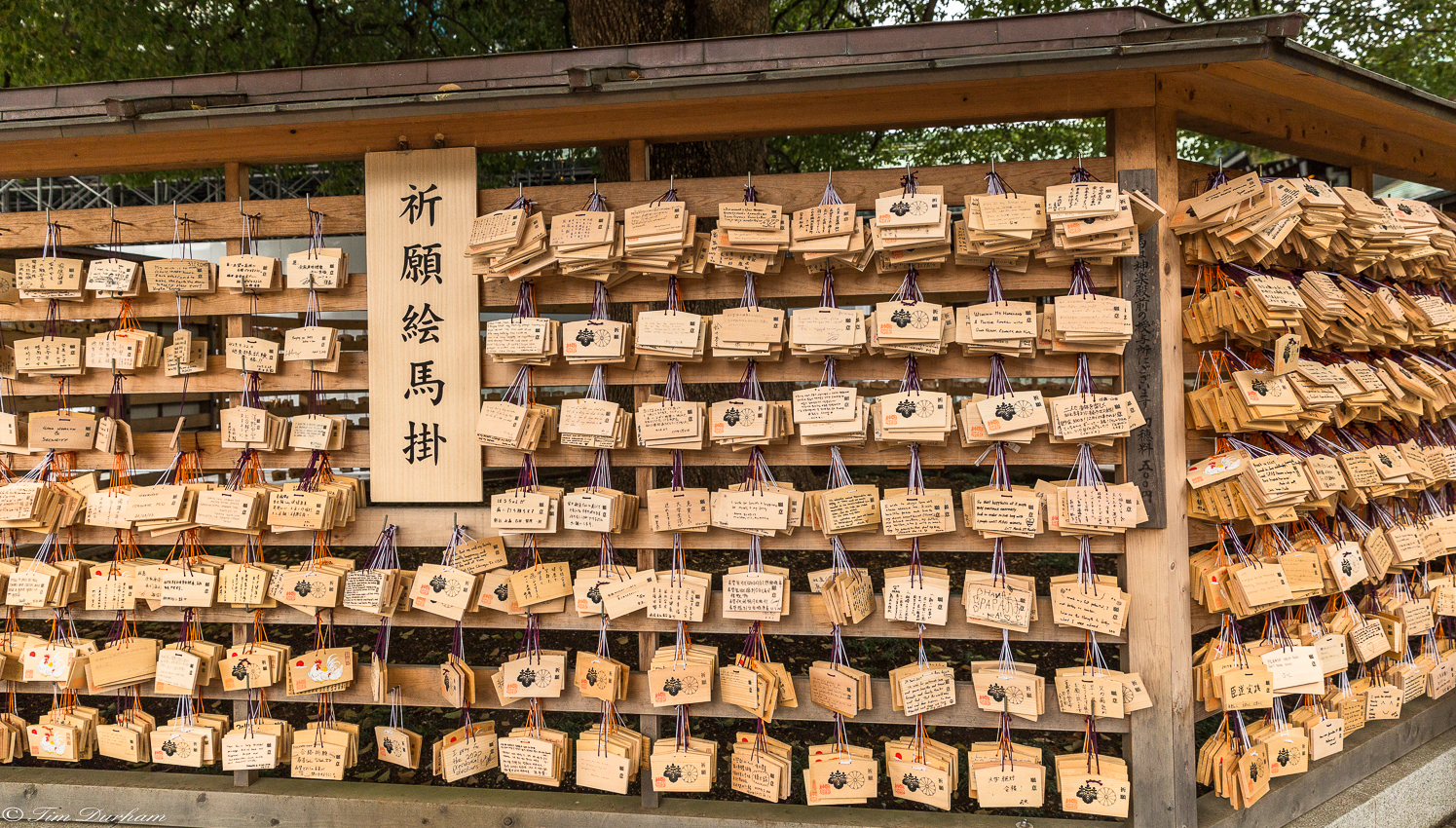
We passed a kiosk as were leaving the Shrine area. These little wooden signs are called ema and are like little votive tablets. Most have prayers or wishes for good health or happiness, success in life, or perhaps good wishes for family and friends. OR, you can get blank ones and write anything you wish. I remember them being around ¥700 (about $7 usd).
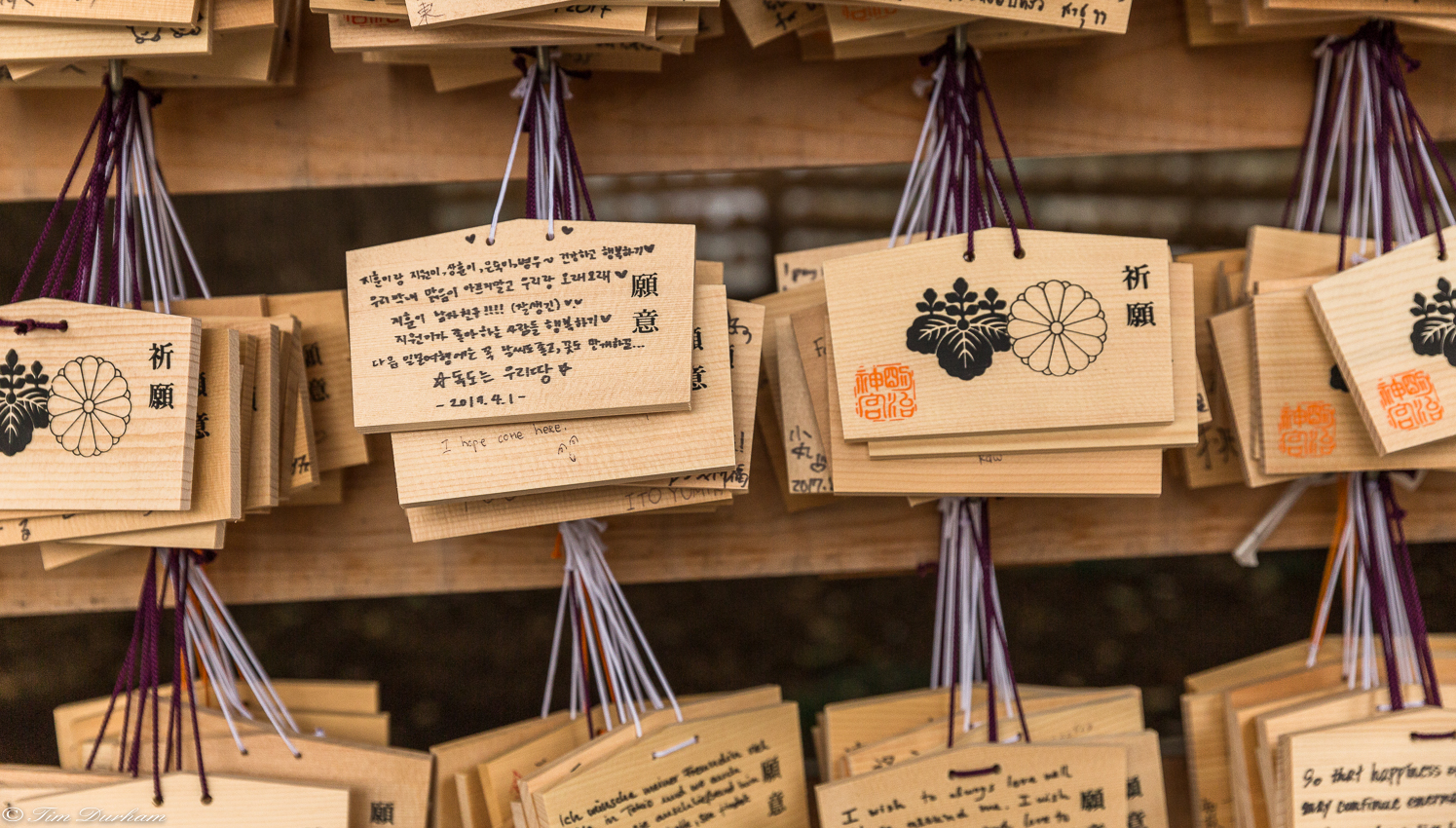
So much for wisely hanging out at the hotel to rehydrate and recuperate. On the other hand, I really did enjoy the party, meeting some people, the shrine, and especially… beginning to learn a few things about
Japanese Tradition and Custom
